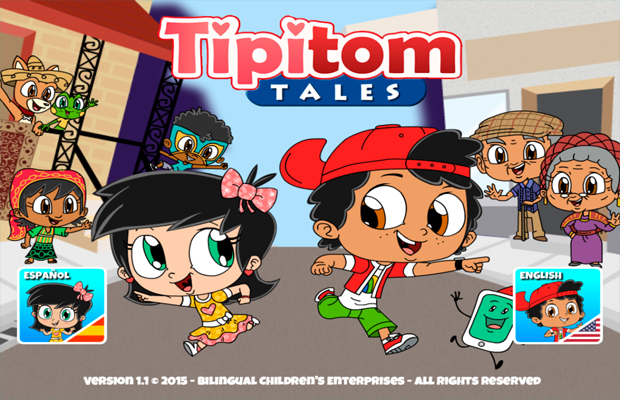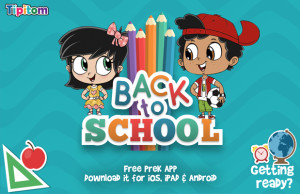This Woman is Changing the World with One App

Deborah Castillero, founder and CEO of Bilingual Children’s Enterprises, knew that only 6% of women who develop startup companies receive funding. This was not an impediment to become an entrepreneur in Silicon Valley. Her objectives and determination were much more important than that fact. In this interview we learn about her great challenge: Launching her own company, inventing an app, developing an educational method that helps to reduce the English learning educational gap among low income children, the process of being an innovator, and the feminine side of the story in the startup world. [READ SPANISH VERSION]
The start-up world is dominated mostly by men, white men. How do you feel as a woman and a Latina navigating those treachery waters?
While it’s a reality, this issue doesn’t really hinder my efforts or tenacity to stay in the game. If this issue had a hold on me, it would probably prevent me from pursuing my vision and purpose. In almost all of my professional experiences, men have always been at the helm of leading the companies I’ve worked for so it’s business as usual for me. I’m certainly not discounting the harsh reality that only 6% of all female founders get funded and less than 3% go to founders of color; call me crazy, but I hope to become one of the few who does obtain funding.
What is more treacherous to a woman is fear. Everyday entrepreneurs have a big bowl of fear for breakfast. I’ve been working with a life coach to address my fears, understand my essence and purpose to minimize those illogical thoughts. While fear will never completely go away, I’m focused on recognizing my strengths and abilities to conquer whatever barrier is placed before me.
How did you get the idea to go from a TV series to an app?
In April (2014), I participated in a bootcamp for female CEO founders in Silicon Valley. I went there assuming I would get a lot out of the program, but no real support from Silicon Valley leaders because I had positioned myself more as a producer. In the process of working one-on-one with the advisors, I realized they saw a much greater and global opportunity for Tipi Tom that wouldn’t be limited by broadcast. This was the eureka moment for me and it was really empowering. At the core, my vision is to accelerate English language development for kids. With a focus on mobile, through a digital media platform, kids can learn wherever they go in a fun and entertaining way. And through animated videos, interactive games and e-books, I’m appealing to the visual, auditory and kinesthetic learner to maximize the learning experience.
How was the transition from music and PR to Silicon Valley? How can you get noticed when the traditional channels are out of reach?
Great question. I’m a major risk taker. Having worked with big name artists like Ricky Martin, Marc Anthony, Jennifer Lopez, Mariah Carey, etc it would have been really easy for me to stay in that industry, but I wasn’t satisfied. When I transitioned from entertainment into media, I had the amazing honor of working with the former executive chairman of Vme Media. I did research on a white paper about the Latino educational crisis and that’s when I decided to take on the challenge of addressing the #wordgap between many lower income Latino kids and higher income early learners. I willingly took on this challenge knowing how hard it would be.
Since we’re mission based and focused on a serious societal issue with negative implications for our economy, amazing people and businesses have been supporting my company including Happy Dog Games, our development team in Costa Rica, Two Animators LLP, our designers, Dr. Zulmaris Diaz, our bilingual education advisor, 11 Dots Agency, our branding and marketing arm, Campbell Brown’s education news & advocacy site the74million.org, Hiplatina.com, Alvaro Serrano from the United Nations Panamerica Office, Hola Kids, a chain of Spanish immersion schools, etc. Through my team and these strategic supporters and partnerships we we’re able to produce all the important elements that went into our first product, the Tipi Tom app.
INTERVIEW by the74million.org
How long did it take you to go from idea to launching?
It took approximately 9 months to design 9 multicultural characters, 2 months to produce a one-minute animated demo and 9 months to build and launch the app. The production process is long so it’s taken us a bit longer than most early startups to launch. It was just three months ago we launched our Tipi Tom app, which is now available for free on the App Store and Google Play.
Do you have mentors? How did you find them?
I do have amazing mentors including Del Medina and Jesse Martinez from Avión; a pre accelerator launched last fall for Latinas with a mobile platform; Steven Lucero, a serial entrepreneur who consistently provides me great insights and direction; he and I met at my demo day at the AT&T Founders. Marc Costafreda, a big supporter who is based in Barcelona and whom I met through the Latino Startup Alliance conference.
What’s your elevator pitch?
BCE is a mobile learning and entertainment platform helping preschoolers learn English, Spanish and other languages. Through Tipi Tom Tales©, a multicultural and character driven property, our platform features short form animated videos, apps and interactive books to accelerate English language development. www.tipitomtales.com
What are the 5 more important key points in your start-up pitch?
1. My personal story as in why I’m doing this and why it’s important
2. The problem and the opportunity
3. My go-to-market strategy
4. Funding requirements
5. My team
DEBORAH CASTILLERO AT WOMEN’S START-UP LAB
Are you getting any help from your famous music clients?
Not yet, but they are on my hit list when the time is right.
Please explain how your Tipi Tom app works
The app opens up with a one minute animated video, mainly in Spanish, with some English vocabulary. There are six activities in total with three different levels – easy, moderate and hard – making the experience appealing to 3, 4 and 5 year olds who love the challenge. After each activity is completed there’s a little celebration to recognize the child’s efforts.
Puzzles
Puzzles help children improve their fine motor skills and ability to see patterns. In the garden or cityscape, kids will make puzzles with Tipi, Tom and/or Abuela Fina.
Memory games
Memory games are known to enhance cognitive skills, train visual memory and increase attention. Here kids will also learn their shapes in two languages.
Let’s Paint
Practicing painting helps develop fine muscle control and strengthens eye-hand motor coordination. With each tap on the paint bucket, kids will learn their colors in two languages. Kids can paint 9 different characters including Tipi, Tom, Abuela Fina, Abuelo Panco, Chico, Cha-Cha, Coquí the Frog, Paco el Perro and Toca the Talking Tablet. There’s also free hand drawing to promote individual creativity.
Match The Color
Matching colors and shapes are ways children observe and categorize what they see. This activity helps kids understand similarities and differences while also learning the names of various fruits in two languages.
Vocabulary
In this activity, kids can review their letters, colors, numbers (1-10) and shapes with pictures and audio, in a mini dictionary.
TIPI TOM TALES VIDEO PRESENTATION
How about your competition, is there space for another language learning app?
I don’t want to talk about our secret sauce in a public forum, but certainly our dual language methodology is our biggest point of distinction.
We believe in a a dual language approach to English and Spanish language development. Dual Language – is a form of education in which students are taught literacy in two separate languages. For example, at a typical dual language school, one day all content is presented in one language; the following day all content is presented in a different/separate language. The majority of dual language programs in the United States teach in English and Spanish.These programs aim for bilingualism (the ability to speak fluently in two languages), biliteracy (the ability to read and write in two languages), academic achievement equal to that of students in non-dual language programs, and cross-cultural competency.
The most effective programs with the greatest potential to develop true bilingual, bicultural, and biliterate students are those that follow a dual language approach. Through early dual language exposure, Tipi Tom will engage preschool children not only in learning two languages but also in reading readiness. Research has shown that dual-language exposure deepens reading and phoneme awareness skills, which are vital to reading success (Pettito & Dunbard, 2004).
Where did the characters come from? Is the content related to your own experience?
I’m the driving force behind the creative of each one of my characters, but they only came alive because of my design team, Two Animators, LLP. Since I have nine characters, I’ll just share a few:
I had a very close relationship with my abuela; she is the reason why I’m an ambicultural Latina and bilingual. Tipi is like me whereby she’s thrown into a new country with a new language where initially she doesn’t understand anyone. I had that experience when I seven years old when my mamá sent me to Panamá to spend the summer with family and my abuelita. Tom is like my cousin Caito who was there to help me learn español while annoying me at the same time. We were inseparable. Abuela Fina, is a triage of myself (I eat organic food), my mom’s name (Fina) and my grandmother’s love for cooking for everyone; in Tipi Tom she has an organic garden and is frequently found in the kitchen cooking for everyone. The love of family is what inspires her daily. Abuelo Panco is named after my deceased Uncle Frank whose nickname was Panco. He was into electronics and I frequently saw him taking things apart and rebuilding them. Abuela Panco is a Geppetto like genius who built a tablet for Tom. Cha-Cha is Tipi’s best friend and also a Kuna Indian. She’s the green princess and represents an indigenous tribe I’ve been working with over the years. There’s more, but I’ll leave that for another conversation.
We’re following a curriculum that’s based upon the US Department of Education’s Ready to Learn Grant, the research conducted by Linda Espinosa, a PhD who is an expert in Early Childhood Education, bilingual and dual language education, and education programs by International Baccalaureate.
How is the user experience?
Kids love Tipi & Tom and the app because it’s fun, entertaining and interactive. We tested early to see what kids thought about the characters, video, storyline and app. With the animated video, all kids sat through the entire viewing and were engaged while demonstrating a clear understanding of the storyline. They were able to recite back specific details about what they saw and heard. The children talked about the apples and lemons, the activity of selecting fruits to cook with and what the different characters were doing in the video. Children laughed and several requested to see the video again.
All kids who had access to the app participated with a high level of engagement. They actively played each level of difficulty within each game; demonstrating a desire to master each level.
With puzzles, the three year olds had some difficulty with the advanced levels, as it required a greater level of finger dexterity. The memory game seemed to be favored by most at all levels, as the children seem to enjoy the challenges presented. The painting activity was also well received and the kids frequently touched the colors to hear them in either Spanish or English.
All the kids played the app independently of their parents.
How does it encourage parents involvement in kids bilingualism?
A big surprise in our early beta testing showed that grandparents really enjoyed playing the app alongside or independent of their grandchildren. I was delighted to see this. I think technology can be intimidating to some abuelos and Tipi Tom makes this experience accessible, fun and entertaining.
Does it help parents handle their own limitations?
Bilingual learning is definitely taking place for all ages and because one of the interactive activities is a mini dictionary, everyone is practicing their numbers, colors, letters and shapes.
What are your immediate plans?
Right now we’re diligently working on a back to school campaign with several organizations. Once we reach a certain milestones, we’ll be able to focus exclusively on fundraising.
DOWNLOAD TIPI TOM TALES HERE:
Android: http://t.co/bAUYADmDZa
iOS: http://ow.ly/MXQCr
Follow TipiTomTales on Twitter: @TipiTomTales
PHOTOS: Courtesy Deborah Castillero, BCE












You must be logged in to post a comment Login